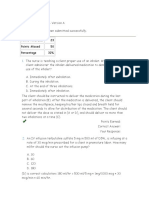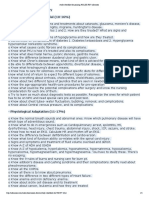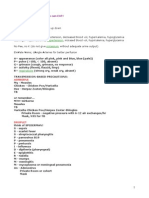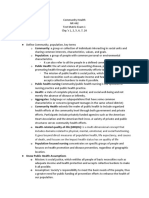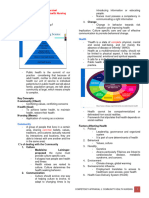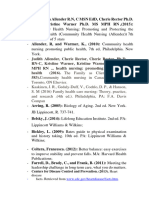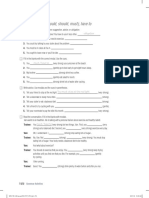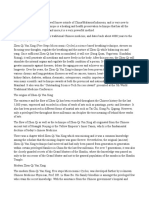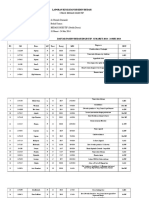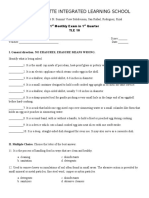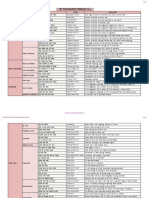Community Health ATI
- A home health nurse is getting ready to see 4 patients? Which one should
she see first?
- Key to answer: which one is more unstable?
- Deteriorating or unstable
- Peak flow meters - take the highest value out of 3 readings
- Normal levels about PT
- COPD patients, lyme disease
- Questions will be from med surg and other books*
- Lead poisoning - what to do or not in the house.. If you have an older
house, not in any books
Chapter 1
Community health nursing theories
- Nightingale’s Theory of the Environment
- Focuses on the impact of the person’s environment on their
health
- Theory of environment: focus is preventative care
- Washing hands
- Maintaining a clean environment - to prevent disease/ spread
of disease
- Health Belief Model
- A person’s primary motivation in taking positive health actions
is to avoid getting a disease
- Likelihood of taking actions based on 4 categories:
1. Modifying variables: gender, age, race, economy
and education.
a. Depending on where they fall with those
things, they may or may not be incline with
taking actions
2. Perceived severity and susceptible
a. Perceive disease is serious and easy to get
it they will be more motivated to take
actions
3. Perceived benefits vs barriers of taking actions
a. If they see a lot of benefits than barriers will
be more likely to take actions
b. Opposites will be true
4. Cues to action
a. Taking advice from doctor
b. Seeing media campaigns about stop
smoking
� c. Getting inundated with cues to actions will
increase their likelihood to take a positive
action to improve their health
Community based nursing vs community oriented
- Community based nursing:
- Client is the community or population as opposed to an individual
- Providing illness care
- Taking care of patients with acute or chronic conditions
- Treating individuals and families
- Examples: home health nurse providing wound care, school
nurse providing an epi injection (hands on specific nursing
care)
- Community oriented nursing:
- Focused on disease prevention, education
- Trying to improve the collective health of the community
- Focus: health education, health promotion and disease prevention
- Public health nurses are community oriented nurses
- Focused on health education, health promotion and disease
prevention
- Not illness care or treating individuals/ families
4 ethical principles in community health nursing
1. Respect for autonomy- patient’s right to self determination
2. Nonmaleficence- not doing any harm to patient
3. Beneficence- doing what is best for the patient, maximize benefits that are
being provided to patient
4. Distributive justice - fair allocation of resources within the community.
a. A community that is underserved and economically challenged and
making sure they are getting fair allocations of resources
Epidemiology- study of the spread, transmission, incidence of disease and injury
3 components of triangle:
- Agent: what is causing the disease
- Bacteria, virus, toxin, noise, pollution
- Host: the human or animal that is being affected by the disease
- Environment: p hysical (water/ food supply or geography), social (access to
health care, work condition and poverty)
- All impact someone’s susceptibility to disease
- Can either increase or decrease someone’s chance of getting a
disease
Incidence: number of new cases of a disease or injury in a population during a
specified period of time
�
Prevalence: number of all cases, including new and pre-existing cases of a
disease or injury in a population during a specified period of time
Community health education:
- Obstacles can include: age, culture, illiteracy, language barriers, lack of
access, lack of motivation
- When we are providing education, we need to understand the different
learning styles
1. Visual: will respond better to videos
2. Auditory: will respond to a verbal lecture or discussion
3. Tactile: hands on learner, will respond best with a hands on
demonstration. Would want them to do a return
demonstration
Healthy People 2020
- A list of national health goals that are major risks to health and wellness to
the US population
- Examples: care of people with diabetes, cancer, older adult health, LGBTQ
- Areas of top concern for public health
- Different goals and outcomes for different areas
- Be familiar with list/ not memorize
Primary prevention: actions that help prevent initial occurrence of disease
- Immunization
- Vaccines
- Providing education (ex: prenatal classes)
- Should be written at an eight grade level or lower
Secondary prevention: focusing on early detection of the disease and limiting the
severity
- See the word screening is secondary prevention
- Disease surveillance
- Helping to control outbreaks
- Checking people for the disease
Tertiary prevention: already have the disease; maximizing recovery after an injury
or illness
- Rehabilitation
- Occupational therapy
- Physical therapy
- Support groups
� - Anytime you see a person has diabetes or osteoporosis - trying to
maximize their recovery is tertiary prevention
Chapter 2
Acculturation: when someone adopts the traits of a different cultures
Ethnocentrism: belief one’s own culture is superior to others
- View the world from their own cultural view point
- Close minded
Culture assessment on a patient should ask questions about the patient’s
background include:
- Ethnic background
- Religious preferences
- Family structure
- Food patterns
- Health practices
- ALWAYS WANT TO INCORPORATE PATIENT PREFERENCES TO
NURSING CARE WHENEVER POSSIBLE*
- Interpreter
- Should NOT use a family member*
- Interpreters need to have knowledge about medical terminology
- A certified medical interpreter
- Patient teaching or education materials should be in the patient’s
language
Environmental risks to health
- Toxins: l ead, pesticides, asbestos, radon
- Air pollution: carbon monoxide, tobacco smoke, airborne lead
contamination
- Water pollution: waste product, chemical runoff from soil
When doing an assessment with a patient on their environment risks should ask
questions about:
- What is the condition of their housing?
- Are they doing any remodeling activities?
- What is the water/ heater temperature set at?
- We want it to be less than 120 F**
- Find out about their occupation
- Are they getting exposure to chemicals or toxins?
- Hairdresser, coal mine (risk for black lung, inhalation)
- Is tobacco smoke present in the home?
- Secondhand smoke and the person smoking
� - Quality about their drinking water
Lead exposure (from practice exams on ATI site)
- It is important to ask a pt and their family when their house was built
- Pre 1978 housing is at high risk for lead based paint
- If you suspect lead to be an issue
- Screen children ages 6 months - 5 years for blood lead levels
- Provide teaching points
- Want to have the kids avoid playing right outside the
home
- Wet mop instead of vacuum, don’t want to pick up the
dust that can be inhaled
- Wet sanding technique instead of dry sanding
techniques
- Children getting enough iron and calcium in their diet
as this helps decrease absorption of lead in the body
- Use cold water instead of hot water because lead
dissolves more quickly in hot water
- If a mom is preparing a bottle of formula should
use cold water instead of hot water, it will be safer
Medicare eligibility
- People over 65 who have been receiving disability for at least 2 years or
diagnosed with ALS or end stage renal disease receiving dialysis
- Part A: covers inpatient hospital expenses, limited skilled nursing
facility services, and home health care
- Part B: c overs outpatient care: diagnostic services, physical therapy
and occupation therapy
- Part C: c ombines part A & B and is offered through private insurance
companies
- Part D: prescription drug coverage; remember D as in drug
Medicaid: those with low socioeconomic status or no other insurance can be
eligible for medicaid. Based on household size and income level
Agencies
1. State department of health: m anages WIC (women infant children
program), oversee CHIP (children’s health insurance program) and
Medicaid.
a. Report notifiable communicable cases to CDC (voluntary for them)
2. State board of nursing: licenses LPNs and RNs, oversee state’s school of
nursing and develop state nursing practice acts
� 3. Local health department: helps meet the health needs of the local
community. Report notifiable communicable diseases to state departments
of health
Chapter 3
- Community assessment: assess people and environment
- People: look at
- Demographic: density and distribution of people
- Biological factors: r ace, age, gender, health and disease status
- Social factors: occupation, education, income and crime rates
- Cultural factors: history, customs, religions
- Environment:
- Physical factors: geography, location of health services,
housing
- Environmental factors: c limate, topography, pollutants, toxins
- How to gather data
- Informant interviews: direct conversations with people in the
community
- Community forum: public meetings
- Secondary data: existing data
- Birth certificates, morbidity data, health records
- Participant observation: observe community activities
- Windshield survey: driving through a community, looking at people
and the place, assessing the place
- Noticing:
- general appearance of people
- signs of violence
- signs of mental illness
- is there drug abuse within the community
- look at quality of housing
- good access to healthcare facilities
- what are the types or availability of grocery stores
- is there public transportation
- Focus groups: meet with a representative sample
- Survey: written - people fill in and written (can be expensive and a
low response rate)
- After gathering data into a database, synthesizing the data,
identifying themes and community needs/ priorities you will be ready
to develop a community health plan:
- Preplanning: brainstorm idea
- Assessment: data collection
- Diagnosis: analyze data to determine health needs of
community and set priorities
� - Planning: interventions, establish goals, identify
responsibilities and set up budget
- Implementation: execute the plan
- Evaluation: determine the effectiveness of your intervention
Chapter 4
Home health nurses: provide healthcare in the pt home or assisted living, nursing
homes
- Provide patient education, direct nursing care and do care coordination
(case manager - provide referrals and help coordinate care for pt)
- Assess home for safety
- No scatter rug because more risks of falling: carpet is good but
loose rugs are not good
- House is free of clutter
- Adequate lighting on stairs
- Colored tape on step edges so can be seen and less likely to fall
- Alzheimer patients: keep locks or alarms on exit doors
- Don’t want to lock bathroom door
- Exit doors are appropriate to lock so that alzheimer’s patients
who wander won’t leave the home and get in trouble
Hospice nurses: help provide palliative care to patients who are dying
- Focus is on symptom management only
- Not helping to cure the patient
- Helping to manage symptoms and support patients and family
through the dying process
Parish nurses: work with pastoral staff to improve the health and wellness of faith
community
- Provide health education and facilitate support groups
- Don’t provide nursing bedside care, not doing hands on nursing tasks like
home health or hospice nurse
Occupational health nurse: role is to promote the health and wellness of
employees and help to prevent workplace illness and injury
- Through surveillance they help identify risks within the work environment
and they identify ways to decrease or eliminate workplace hazards
- Primary prevention: provide safety education
- Secondary prevention: screenings
- Tertiary prevention: help provide limited duty programs to those
employees who have been hurt
- Need to keep closely informed of OSHA standards so the workplace is
meeting those standards
�
School nurses: provide direct nursing care to children at the school
- Provide health education
- Act as a case manager for children who have health needs -- referrals,
schedule appointments, coordinate services for these children
- Primary prevention: assessing immunization status of children at the
school
- Secondary prevention: s creening of-
- Vision and hearing
- Oral health
- Scoliosis
- Infestation (lice or scabies)
- Assess children for neglect or abuse
- Tertiary prevention: administer medications and provide nursing care for
kids with chronic disease
- Help assess children with disabilities
Key health concerns for certain age/ demographics
Infants
- SIDS (a big concern): encourage parents to put babies to sleep on back
Children
- Immunization
- Free from injury (using helmet when riding bike & making sure to use
seatbelts when in the car)
Adolescents
- Motor vehicle accidents (wearing seatbelts, and the risk of substance
abuse (smoking), safe sex practices and assess their mental health (suicide,
anxiety, depression are key concerns with this age group)
Women
- As they get older Osteoporosis is a big concern after menopause
- Encourage women to engage in weight bearing exercises
- Making sure enough calcium & vitamin D
- Heart disease
- Cancer prevention
- Encourage women to have mammograms and pap smears
- Diabetes
Men
- Heart disease
- Cancer prevention
- Prostate cancer screening
- Testicular self exams
- Lung disease due to smoking
- Liver disease due to excessive alcohol intake
�
Older adults
- Heart disease
- CVA
- COPD
- Pneumonia is common
- Polypharmacy- taking lots of different medications, interactions &
metabolism isn’t that good at a higher risk of toxicity
- Cancer
- Injury prevention - falls is something to be in concern with
Families
- times of transition: Birth or adoption of a child, a death in a family, major
illness, divorce, loss of income -- most important to know: these times in
transitions create high risk for the family, a lot of issues that come up when
having these types of transitions
- Assessing a family
- Genogram: g raphical representation of relationships within the
family and patterns of illness
- Who has what disease and what age did they died
- Ecomap: graphical representation of family interaction with outside
groups and organizations
- Provides info about the family’s support network
Chapter 5
Violence
- Homicide: o ften related to substance abuse
- Victim is known to perpetrator
- Males are at higher risk of homicide than females
- Rape:
- Intimate partner violence is very common
- Often underreported
- In the position to council someone who was raped: advise them not
to bathe following the assault because it can destroy the medical
evidence
- Should not bathe and then receive medical care so evidence
can be collected
- Suicide
- Highest in men and those over 65
- Abuse
- Physical
- Sexual
- Emotional: humiliation, intimidation
� - Neglect: failure to provide food, shelter, emotional care, medical care
or education to someone you are responsible for
- Economic: misuse of money, failure to provide needs of the victim
despite adequate funds or theft of the money
Community factors that increase the risk of violence within the population:
- Unemployment
- Poverty
- Social isolation
- Child abuse is more common if spousal abuse is present
- Important to recognize signs of child abuse:
- Presence of wounds or injuries in various states of healing
- Unexplained bruises or injuries
- Unusual fear of others from the child
- Small round burns that can be caused by cigarettes
- Four arm spiral fractures
- Child neglect:
- Poor hygiene
- Inappropriate dress for the weather
- Signs of malnourishment
- Withdrawal
- School absences
Substance abuse
Alcohol abuse:
- Many things that affect a body’s metabolism of alcohol
- Size and weight of drinker
- Time lapse while drinking
- Gender
- Food presence in their stomach
- Important to note manifestation of alcohol withdrawal typically
appear within 4- 12 hours
- Withdrawal symptoms
- Tachycardia, HTN, N/V, headache, anxiety, irritability,
diaphoresis, seizures, tremors
- Important when assessing a patient: to find out when they had their
last drink to determine their time of acute withdrawal
- Primary prevention: public education campaigns and school education
- Secondary prevention: screening individual for signs of abuse
- Tertiary prevention: refer patients who are having substance abuse
problems to AA or NA; help to promote better coping skills and better
lifestyle changes in the patient
Homeless
� - Fastest growing segment of people who are homeless includes families with
children
- Risk factors: unemployed, migrant workers, veterans, those suffering from
mental illness or substance abuse, HIV/ AIDS are at a higher risk of being
homeless and at rescue
- Key health issues within the homeless population:
- TB, infestation (scabies or lice), substance abuse, HIV/AIDs, mental
illness
- Fairly prevalent within homeless population
- Key Health issues of veterans
- Mental health issues: PTSD and depression
- Substance abuse
- suicide: high rates
- Traumatic brain injury
- Spinal cord injuries
- Amputations
Migrant workers
- Health risks:
- TB
- Dental disease
- Skin cancer - out in the sun a lot
- Diabetes
- Obesity
- High risk of suicide
- Increased work related injuries due to exposure to pesticides and
injuries from machinery
- Primary prevention: providing education to reduce exposure to pesticides,
accident prevention, preventative care - immunizations and dental care
- Secondary prevention: s creening for skin cancer, pesticide exposure,
communicable diseases (ex- TB)
- Tertiary prevention: provide ER or primary care services as appropriate,
including treatments of pesticide exposure
- Tertiary: after they have the exposure or some kind of disease need
to help get them the care they need and to maximize their
functionality to moving forward
Chapter 6
Communicable diseases:
- mode of transmission: through air, food, water
Airborne
- Chickenpox
� - Measles
- TB
- Pertussis
- Influenza
Foodborne
- Salmonella
- Hep A (fecal oral)
- E. Coli
- Botulism
Waterborne
- Cholera
- Typhoid fever
Vector borne
- Lyme disease
- Malaria
- Rocky mountain spotted fever
Sexually transmitted diseases
- HIV
- Hep B, C, D
- Syphilis
- HPV
- Gonorrhea
Direct contact
- Scabies
- Lice
- Impetigo
- Mononucleosis (kissing disease - spread through saliva)
Herd Immunity- where most community members have an immunity against a
disease. This helps protect individuals in a population who can’t get vaccinated
(getting chemotherapy, immunocompromised, too young) having most members
of the community helps them.
- Herd immunity is being threatened these days because more and more
people are not getting vaccinated as that happens, people who are
vulnerable in the population have a higher risk to getting those diseases.
- Herd immunity in a perfect world makes exposure unlikely bc most
community members are vaccinated and have immunity.
4 Types of immunity
Active natural immunity- where body produces antibodies in response to
exposure of a live pathogen.
- Exposed to pathogen and may get sick. The body develops antibodies so
next time exposed can fight off more effectively
�Active artificial immunity- a vaccine with a dead or weakened pathogen that
causes the body to produce antibodies, to protect you against actual live
exposure to the pathogen
Passive natural immunity- antibodies are passed from the mom to the baby
through the breast milk or placenta. Baby’s immune system is very immature, they
don’t have to build up antibodies they get it passively from mom.
Passive artificial immunity- immunoglobulins are administered to an individual
after they’ve been exposed from pathogen
Reporting requirements for communicable disease
- Communicable disease reporting is mandated by state and local
regulations. NOT a national regulation
- State notification to the CDC is voluntary
Primary, secondary, tertiary prevention about communicable diseases
Primary prevention: education on immunization, encouraging hand hygiene,
teaching proper food handling, advising patient of risks of infectious diseases
when going to other countries (hep A is a big risk when travelling to certain
countries)
Secondary prevention: screening for communicable diseases, quarantine pts
when needed, refer suspected cases of diseases for definitive diagnosis
Tertiary prevention: monitor treatment compliance, direct observation therapy- if
a patient is noncompliant when taking their medication, they can pose risk to
society to spread the disease they have so we need to watch them take their
medications
Nationally notifiable list of communicable diseases
- Look in book*
Anthrax
- Person who has been exposed is recommended to get IV cipro after
exposure
Lyme disease
- Symptoms: white center where the tic was and bull’s eye red ring around
there
Meningitis
- Kids sent to college to a dorm setting it is recommended they get
meningitis vaccine. Also recommended to a crowded environment --
military, housing, prison will benefit from vaccine
Pertussis
� - Symptoms: whooping cough
- Child in school diagnoses with pertussis would need to stay at home until
coughing is gone
- May need to give erythromycin for 7 days for those exposed
- Family members who were exposed need to be treated prophylactically for
pertussis
- Important to check immunization status of the other children in the child’s
school
Smallpox
- Starts as a rash on the face and moves down the body
Syphilis
- Early sign: sore on genitals (called a chancre)
Chapter 7
Disaster management--
1st level Disaster prevention:
- Surveillance, inspections, immunizations, education and risk assessment
2nd level Disaster Preparedness:
- Creating a disaster action plan
- Identifying evacuation routes
- Creating a disaster kit
- Identifying a meeting place & a communication plan
- Performing drills ** important to know that this occurs in disaster
preparedness
3rd level Disaster Response:
- Assess the extent of disaster
- Perform Triage
- Direct those affected
- Coordinate evacuations and possibly help quarantine
4th disaster recovery:
- Begins when there is no longer danger present
- Coordinate care in shelters in homes
- And start process of recovery
Bioterrorism
Category A: smallpox, botulism, anthrax, plague
Category B: typhus, cholera
Category C: Hantavirus
Inhaled anthrax: symptoms include: severe dyspnea, fever, shock and muscle
aches
- Administer IV cipro to those exposed or who have a high risk of exposure
�
Smallpox: starts with rash on face that moves down the body
- Symptoms: high fever, vomiting, headache
- Prevention is through vaccination
Chapter 7
Consultation- a provider puts a request to another provider or another resource
who can provide expert advice and/or services for the patient
- In the hospital the doctors do a consultation to another nurse
Referrals - a provider requests or recommends management of one or more of a
patient’s concerns or issues to another provider, or they can recommend support
services (support groups, churches, transportation services, meal delivery
services) often a case manager provides referrals for patients
Case managers
- Play a super important role in the hospital
- Sometimes called “care coordinators”
- Instrumental in helping a pt move from acute care to home to a nursing
skilled facility. Making they have everything they need, equipment, follow
up appointment
- Case manager responsibilities:
- Help transition from acute care to community based care
- Evaluate the patient’s medical needs, psychosocial needs, financial
constraints
- Work with pt’s insurance companies to see what covers or what
works best for patient
- Collaborate with patient, family, insurance company, health care
providers, medical service & equipment providers to meet the
healthcare needs of the patient
- Help facilitate discussion of patient’s needs
- With interprofessional team (doctors, bedside nurses)
- Provide referrals as needed for those support services
3 different concepts
Informatics- this field incorporates nursing as well as information technology and
communication technology to develop and support nursing practice and
improve patient outcomes
- Combines computer science and nursing to help manage our systems and
how we do our communication & providing patient care
Telehealth- delivery of healthcare through technology vs in person
- Particularly helpful in rural areas where they lack specialists.
� - Patients can connect with specialists who don’t provide services near
them thru telehealth & helps fill the void that is seen in rural areas
Nursing roles in health policy
- Nurses can always act as advocates for changes in health policy
- Can help lobby legislators
- Serve in public office
- Form coalitions (collaboration of groups to achieve a goal) in hopes to
improve our community’s health and wellness
- Be aware how a nurse can act as an advocate in our society*
Testing our knowledge from med surg, pharmacology besides from community **




































